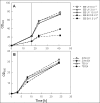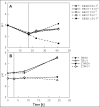High-yield production of biologically active recombinant protein in shake flask culture by combination of enzyme-based glucose delivery and increased oxygen transfer
- PMID: 22152005
- PMCID: PMC3258199
- DOI: 10.1186/1475-2859-10-107
High-yield production of biologically active recombinant protein in shake flask culture by combination of enzyme-based glucose delivery and increased oxygen transfer
Abstract
This report describes the combined use of an enzyme-based glucose release system (EnBase®) and high-aeration shake flask (Ultra Yield Flask™). The benefit of this combination is demonstrated by over 100-fold improvement in the active yield of recombinant alcohol dehydrogenase expressed in E. coli. Compared to Terrific Broth and ZYM-5052 autoinduction medium, the EnBase system improved yield mainly through increased productivity per cell. Four-fold increase in oxygen transfer by the Ultra Yield Flask contributed to higher cell density with EnBase but not with the other tested media, and consequently the product yield per ml of EnBase culture was further improved.
Figures






Similar articles
-
High Yield of Recombinant Protein in Shaken E. coli Cultures with Enzymatic Glucose Release Medium EnPresso B.Methods Mol Biol. 2017;1586:127-137. doi: 10.1007/978-1-4939-6887-9_8. Methods Mol Biol. 2017. PMID: 28470602
-
A novel fed-batch based cultivation method provides high cell-density and improves yield of soluble recombinant proteins in shaken cultures.Microb Cell Fact. 2010 Feb 19;9:11. doi: 10.1186/1475-2859-9-11. Microb Cell Fact. 2010. PMID: 20167131 Free PMC article.
-
Growth and recombinant protein expression with Escherichia coli in different batch cultivation media.Appl Microbiol Biotechnol. 2011 Apr;90(1):69-76. doi: 10.1007/s00253-010-3036-y. Epub 2010 Dec 23. Appl Microbiol Biotechnol. 2011. PMID: 21181153
-
The fed-batch principle for the molecular biology lab: controlled nutrient diets in ready-made media improve production of recombinant proteins in Escherichia coli.Microb Cell Fact. 2016 Jun 17;15(1):110. doi: 10.1186/s12934-016-0513-8. Microb Cell Fact. 2016. PMID: 27317421 Free PMC article. Review.
-
Ethanol production from lignocellulosic biomass by recombinant Escherichia coli strain FBR5.Bioengineered. 2012 Jul-Aug;3(4):197-202. doi: 10.4161/bioe.19874. Epub 2012 Jun 18. Bioengineered. 2012. PMID: 22705843 Free PMC article. Review.
Cited by
-
Protein production in Yarrowia lipolytica via fusion to the secreted lipase Lip2p.Mol Biotechnol. 2014 Jan;56(1):79-90. doi: 10.1007/s12033-013-9684-2. Mol Biotechnol. 2014. PMID: 23852986
-
High-yield production of functional soluble single-domain antibodies in the cytoplasm of Escherichia coli.Microb Cell Fact. 2013 Oct 27;12:97. doi: 10.1186/1475-2859-12-97. Microb Cell Fact. 2013. PMID: 24161153 Free PMC article.
-
High cell density cultivation of E. coli in shake flasks for the production of recombinant proteins.Biotechnol Rep (Amst). 2021 Dec 21;33:e00694. doi: 10.1016/j.btre.2021.e00694. eCollection 2022 Mar. Biotechnol Rep (Amst). 2021. PMID: 35004235 Free PMC article.
-
Production of the polyketide 6-deoxyerythronolide B in the heterologous host Bacillus subtilis.Appl Microbiol Biotechnol. 2016 Feb;100(3):1209-1220. doi: 10.1007/s00253-015-6990-6. Epub 2015 Oct 2. Appl Microbiol Biotechnol. 2016. PMID: 26432460 Free PMC article.
-
Expression of the functional recombinant human glycosyltransferase GalNAcT2 in Escherichia coli.Microb Cell Fact. 2015 Jan 13;14:3. doi: 10.1186/s12934-014-0186-0. Microb Cell Fact. 2015. PMID: 25582753 Free PMC article.
References
-
- Krause M, Ukkonen K, Haataja T, Ruottinen M, Glumoff T, Neubauer A, Neubauer P, Vasala A. A novel fed-batch based cultivation method provides high cell-density and improves yield of soluble recombinant proteins in shaken cultures. Microb Cell Fact. 2010;9:11. doi: 10.1186/1475-2859-9-11. - DOI - PMC - PubMed
Publication types
MeSH terms
Substances
LinkOut - more resources
Full Text Sources

